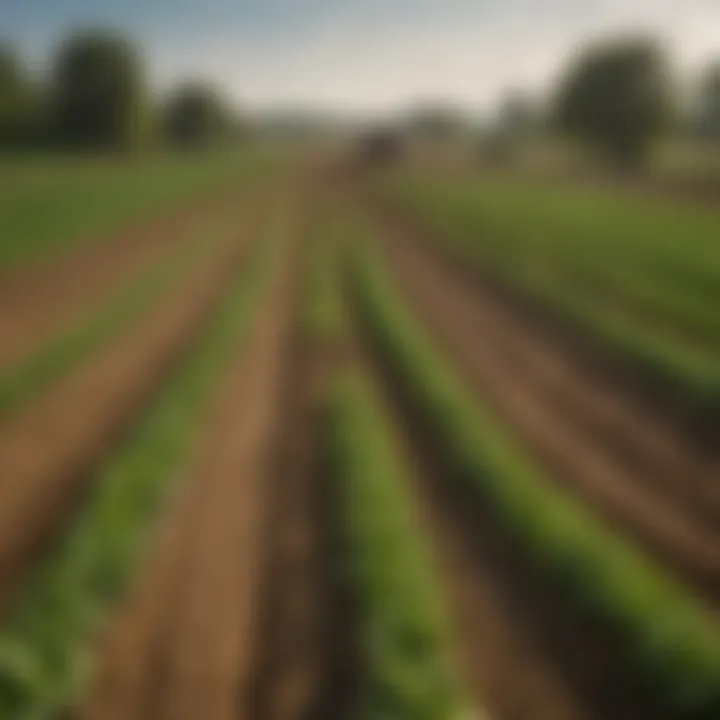Understanding Rotational Planting for Crop Management


Intro
Rotational planting is a crucial method in modern agriculture that seeks to improve soil health and enhance overall crop management. By alternating the types of crops grown in a specific area, farmers can foster a balanced ecosystem that promotes biodiversity and reduces the prevalence of pests and diseases. This technique is not only beneficial for the crops but also for the environment, as it encourages sustainable farming practices.
In this article, we will examine the various aspects of rotational planting. We will begin with an overview of what rotational planting entails and why it is important. Following that, we will delve into key techniques and innovations that drive this practice. Finally, we will explore practical applications through guided steps and examples from real-world scenarios.
Topic Overview
Definition and Importance
Rotational planting refers to the systematic practice of changing the species of crops grown on a particular piece of land over seasons or growing cycles. This method plays a vital role in enhancing soil fertility and structure. Additionally, it aids in pest control as different crops can disrupt the life cycles of pests. Through these methods, farmers can achieve sustainable agricultural systems that yield better results over time.
Brief History and Evolution
The concept of crop rotation is not new. Historically, ancient civilizations understood its value. For example, Romans practiced a form of crop rotation to maintain soil health. Over time, as agriculture evolved, so did the techniques employed. Modern approaches now incorporate scientific methods and technology to optimize the process. Understanding this evolution is essential for appreciating how rotational planting fits into today’s agricultural landscape.
Key Techniques and Innovations
Sustainable Farming Practices
Utilizing rotational planting involves specific sustainable farming practices. These include:
- Diversification of crops: Planting various types of crops nourishes the soil in different ways and reduces the risk of disease.
- Cover crops: These crops protect the soil and improve its structure by minimizing erosion.
- Minimal tillage: Reducing tillage helps maintain soil organisms and structure.
Advanced Agronomic Technologies
With the advancement of technology, farmers now have access to precision agriculture tools that enhance the effectiveness of rotational planting. Technologies such as soil sensors, drones for monitoring crop health, and data analytics are becoming commonplace. These tools provide insights that lead to better crop decisions and resource management.
Practical Applications
Step-by-Step Guides
To implement rotational planting effectively, farmers can follow a structured approach:
- Assess soil condition: Conduct soil tests to determine nutrient levels.
- Plan crop rotation: Choose crops that complement each other and enrich the soil.
- Monitor and adjust: Continuously observe crop performance and soil health, making adjustments as necessary.
Case Studies or Real-World Examples
Several farms have successfully applied rotational planting methods. For example, in Iowa, a farmer adopted a rotation between corn and soybeans, leading to a significant decrease in pest populations and an increase in yield. This real-world scenario underscores the effectiveness of diversified planting strategies.
"Rotational planting not only enhances productivity but fosters a healthier ecosystem, benefiting both crops and the environment."
Intro to Rotational Planting
Rotational planting is a crucial strategy in modern agriculture that aims to enhance crop management through varied crop sequencing. This practice is not merely a method for farmers to plant different crops each season; it involves a deeper understanding of soil health, pest management, and environmental sustainability. The core benefit of rotational planting lies in its ability to improve soil fertility and promote diverse agricultural ecosystems.
Farming is increasingly challenged by declining soil quality, rising pest populations, and changing climate conditions. Therefore, understanding the intricacies of rotational planting equips farmers with essential tools to address these modern challenges effectively. As the agricultural landscape evolves, the relevance of adopting rotational practices becomes ever more apparent. By engaging in this practice, farmers can foster resilient and productive farming systems that contribute to long-term sustainability.
Definition and Historical Context
Rotational planting refers to the systematic practice of planting different crops in sequential seasons within the same field. Historically, this approach has roots in ancient farming cultures, where farmers observed the benefits of alternating crops. The historical context reveals that various civilizations utilized crop rotation to enhance soil nutrients, combat diseases, and ward off pests.
For instance, the ancient Romans practiced crop rotation, which included legumes, to rehabilitate soil and increase fertility after planting cereals. Throughout the years, these practices evolved, adapting to the specific climates and soil conditions found across the globe. The experience gained over centuries provides a framework upon which today's advanced agricultural systems can build upon.
The Philosophy Behind Rotational Planting
The philosophy of rotational planting is grounded in the principles of diversity and interdependence within ecosystems. This method seeks not only to optimize the yield from a single plot of land but also to create a balance within the farming environment. Rotation effectively breaks the life cycles of pests and diseases, reducing the need for chemical inputs and fostering healthier soils.


Moreover, certain crops, such as legumes, play a significant role in enhancing nitrogen content in the soil, enriching it naturally. The systematic approach of rotating crops encourages a sustainable cycle that respects ecological boundaries. Farmers embracing this philosophy are likely to see not just improved immediate outputs but also enhanced long-term viability of their agricultural practices. The ultimate aim is to create a resilient farming ecosystem that adapts to challenges, embraces biodiversity, and contributes positively to the environment.
Fundamental Principles of Rotational Planting
Understanding the fundamental principles of rotational planting is crucial for successful crop management. This approach not only improves soil health but also enhances crop productivity and minimizes pest pressure. These principles are rooted in ecological practices that lead to a more sustainable form of agriculture.
Crop Diversity and Soil Health
Crop diversity is a key element in rotational planting. By changing the type of crops planted in a specific sequence, farmers can improve the biodiversity of the field. Diverse crops help maintain soil structure and nutritional content. This change also makes it harder for pests and diseases to thrive due to the variety of plants present.
Growing different crops rotates beneficial microbes within the soil. These microbes break down organic matter and release nutrients back into the soil. Improved soil health leads to better water retention and less erosion, contributing to sustainable farming. To maximize these benefits, it’s advisable to include legumes in the rotation plan. Legumes fix nitrogen in the soil, which is essential for the next crop cycle.
Pest and Disease Control
Another fundamental principle centers on pest and disease control. Rotational planting disrupts the life cycles of pests that may have adapted to a particular host plant. When the same crop is grown continuously, pests can build up their populations to levels that can cause significant damage. In contrast, rotating crops reduces the likelihood of these pests sustaining themselves over extended periods.
In addition, introducing diverse crops can help in reducing specific diseases that may adversely affect certain plants. Some crops can act as traps for pests or reduce the frequency of certain diseases by changing the biological factors in the soil and surrounding environment. Integrating different species in the planting strategy leads to a more balanced ecosystem.
Nutrient Management
Nutrient management is a fundamental aspect of rotational planting. Different crops have varying nutrient needs and uptake patterns. By rotating crops, farmers can optimize the use of nutrients in the soil. For example, deep-rooted plants can access nutrients that shallow-rooted plants may not reach. This targeted approach helps in maximizing nutrient availability and reduces the need for synthetic fertilizers over time.
Moreover, including cover crops in the rotation can build organic matter. This organic matter enhances the soil's ability to hold nutrients and retain moisture. As a result, crop productivity can significantly improve. Sustainable nutrient management ensures that farmers can maintain high yields without depleting soil resources.
The successful application of rotational planting relies on understanding how these fundamental principles interconnect to foster robust agricultural systems and sustainable farming practices.
Types of Rotational Planting
Understanding the types of rotational planting is crucial for effective agricultural management. Each strategy offers unique benefits and demands specific considerations, catering to various farming systems. It helps farmers diversify their crops, reduce soil degradation, and enhance productivity. The knowledge of different types allows for informed decisions that can improve soil health and crop resilience.
Sequential Crop Rotation
Sequential crop rotation involves the systematic planting of different crops in a specific sequence over time. This method not only helps decrease pest pressures but also optimizes nutrient use. For example, planting legumes after cereal crops replenishes nitrogen levels in the soil. The rotation schedule must be designed carefully, considering seasonal conditions and crop compatibility. By doing so, farmers can achieve a robust crop structure that supports regular harvests while maintaining soil vitality.
"Sequential crop rotation can significantly enhance the regenerative capacity of soil, making it a favored approach among sustainable farmers."
Cover Cropping Strategies
Cover cropping is another vital technique in rotational planting. This method involves growing crops specifically for soil protection during off-seasons. Typical cover crops include clover, rye, and vetch. They can prevent soil erosion, suppress weeds, and improve soil structure. Moreover, cover crops contribute organic matter that enhances soil fertility. Selecting the right cover crop is essential, as some may better suit particular climates or soil conditions than others. Implementing cover cropping alongside main crops effectively creates a diversified agricultural system.
Intercropping Techniques
Intercropping refers to the practice of cultivating two or more crops simultaneously in the same field. This strategy aims to maximize land use and promote biodiversity. For instance, growing corn with beans allows for efficient nutrient use; beans fix nitrogen, benefiting corn growth. Successful intercropping requires careful planning regarding crop height, growth rate, and resource requirements. Such interactions can improve resilience against pests and weather variability. Therefore, intercropping becomes a dynamic approach to enhance both crop yields and environmental stability.
Implementing Rotational Planting
Implementing rotational planting is a crucial step in achieving sustainable agriculture. This practice not only promotes crop health but also enhances soil vitality and resilience against pests and diseases. By diversifying crop production, farmers can create a balanced ecosystem that supports both agricultural output and environmental integrity. Understanding the nuances of implementing rotational planting is paramount for any farmer aiming to optimize their yield and safeguard their livelihoods. Below, we explore the key aspects involved in successfully implementing this agricultural strategy.
Planning and Design
Effective planning is essential for successful rotational planting. Farmers should begin by analyzing their land, including its soil characteristics, climate conditions, and local pest pressures. A well-thought-out design considers the compatibility of different crops. It is important to select crops that can provide benefits when rotated, such as those that fix nitrogen in the soil or those that are resilient to local pests.
Additionally, farmers may want to consider the timing of planting and harvesting. This ensures that planted crops do not create competition for resources and helps maximize the use of available sunlight and nutrients.
Here are few important points to consider:
- Assess soil health and fertility levels.
- Identify crops that suit local conditions and market demand.
- Create a timeline that aligns with crop growth cycles.
- Plan for fallow periods where necessary to allow soil recovery.
Soil Preparation and Crop Selection


Proper soil preparation is fundamental to rotational planting. Crop rotation affects soil structure and nutrient composition. Therefore, it is essential to prepare the soil before the planting season. This involves tilling, testing for nutrient levels, and amending the soil based on the specific needs of the crops to be planted.
When it comes to crop selection, farmers should choose a variety of crops that complement each other’s growth. For instance, pairing deep-rooted plants with shallow-rooted ones can enhance overall nutrient uptake. It is also advisable to rotate crops that have different nutrient demands to prevent soil depletion.
Moreover, considering cover crops adds an extra layer of protection and enhancement to soil quality. Cover crops can help reduce erosion, improve soil structure, and enhance overall soil fertility during off-seasons.
Monitoring and Adjusting the Rotation
To ensure the success of rotational planting, continuous monitoring is essential. Farmers need to keep track of crop performance, soil health, and pest pressures throughout the growing season. This evaluation allows for adjustments in the rotation plan as needed.
For example, if a particular crop is showing signs of stress or pest damage, it may be wise to modify the rotation to include a different type of crop that is more resilient to local conditions. Farmers can also employ various monitoring tools, such as soil moisture sensors and crop health indicators, to gather precise data on the field conditions.
- Track soil nutrient levels regularly.
- Look out for pest and disease patterns.
- Adjust crop choices or planting schedules based on observations.
Implementing rotational planting is a dynamic process that can require flexibility and adaptation. With careful planning, soil preparation, and active monitoring, farmers can cultivate a sustainable and profitable agricultural environment.
Benefits of Rotational Planting
Rotational planting offers numerous advantages that are crucial for promoting healthier agricultural practices. Farmers who implement this method can experience improvements not only in soil quality but also in crop production and environmental sustainability. These benefits evolve from a careful balance of managing soil nutrients, reducing pests, and adapting to market demands.
Enhanced Soil Fertility
One of the foremost benefits of rotational planting is the enhancement of soil fertility. By alternating crops, farmers can prevent nutrient depletion that often occurs with monoculture. Different plants have varying nutrient requirements. For instance, legumes like soybeans fix nitrogen in the soil, enriching it for subsequent crops. This has a direct positive impact on the soil structure and microbial activity.
Moreover, crop residues from different plants contribute organic matter to the soil. The decomposition of this matter improves soil texture, increases moisture retention, and provides essential nutrients over time. This healthy soil ecosystem supports greater biodiversity, which is vital for sustainable agriculture.
"Diverse crops lead to a more resilient soil ecosystem, which in turn supports healthier plants and yields."
Increased Crop Yields
Crop rotation has a proven record of boosting overall yields. When farmers plant diverse crops in rotation, they often see better productivity. This increase can be attributed to multiple factors, including optimized nutrient availability and reduced pest populations. For example, certain crops can deter pest infestations specific to other plants, leading to healthier harvests.
Additionally, rotating crops can mitigate the impact of diseases that affect specific plants. When a sensitive crop follows one that is resistant to particular diseases, the overall health of the subsequent crop improves. As a result, the economic returns for farmers increase significantly, making rotational planting not only an agronomic decision but a financially sound one as well.
Sustainability and Environmental Impact
Rotational planting aligns well with sustainable agricultural practices. It addresses various environmental concerns, such as soil erosion, water management, and loss of biodiversity. Given that different crops utilize resources differently, the overall demands on soil and water are balanced, contributing to long-term sustainability.
Furthermore, using fewer chemical fertilizers and pesticides can reduce agricultural runoff and pollution, improving local ecosystems. Utilizing natural pest control through crop diversity minimizes the reliance on harmful chemicals. Accepting these practices promotes ecological well-being and contributes to a healthier planet.
In summary, by enriching soil, increasing yields, and supporting sustainability, rotational planting presents a holistic approach to modern farming. Each of these benefits drives home the necessity of adopting this practice for both agricultural and ecological gains.
Challenges in Rotational Planting
Rotational planting presents several challenges that farmers must navigate. Understanding these challenges is crucial to developing effective strategies for successful implementation. The complexity of agricultural systems demands that any potential barriers be identified and addressed proactively. These challenges not only affect the feasibility of implementing a rotational planting system but also influence the long-term sustainability of farming practices.
Economic Considerations
Economic factors play a significant role in the decision-making process for rotational planting. Transitioning to a rotational planting system may involve initial costs, including changes to machinery, seed purchasing, and soil amendments. These financial investments can be daunting for many farmers, particularly those with tight margins.
Farmers need to evaluate the potential return on investment. On the one hand, rotational planting can lead to increased yields and soil health. On the other hand, the upfront costs can be a barrier. Market prices for different crops can also vary significantly. Therefore, selecting the right crop combination for rotation is essential. Crop prices fluctuate, and understanding market trends will better inform planting decisions.
"Considering economic viability is key to maximizing benefits of rotational planting for any farm operation."
Knowledge and Expertise Requirements
Implementing a rotational planting strategy necessitates specific agricultural knowledge and skills. Farmers must be well-versed in their local soils, climate patterns, and crop requirements. Without this knowledge, they may not select appropriate crop combinations for rotation, which can ultimately compromise yield and soil health.
Moreover, ongoing education is important. Agricultural techniques evolve, and new research can provide insights into effective practices. This can include understanding pest behavior, disease resistance, and nutrient management. Participating in workshops or farming cooperatives can enhance expertise. Many farmers benefit from mentorship or consultation with agronomists. This helps them make informed decisions and implement best practices effectively.


Market Access and Crop Demand
Accessing markets and understanding crop demand significantly influence the success of rotational planting. Farmers can produce a variety of crops through rotation. However, it's necessary to ensure that these crops have a viable market. Crop rotation can mean shifting to less familiar crops, and this may pose challenges if markets for these crops are limited.
Additionally, logistics and distribution become essential factors. Farmers may need to establish direct connections with consumers, distributors, or processers. It can be helpful to study market demand and trends to identify high-value crops that align with consumer preferences. Building relationships within the local agricultural community can improve market access and ensure balanced demand.
In summary, while rotational planting brings distinct advantages, challenges such as economic factors, knowledge requirements, and market access need thorough consideration. Addressing these challenges head-on is vital for successful implementation and the overall sustainability of agricultural practices.
Case Studies on Successful Rotational Planting
Exploring case studies on successful rotational planting sheds light on practical applications and outcomes across various contexts. It offers critical insights that can apply to diverse agricultural scenarios. By examining real-world examples, farmers and researchers can understand the effectiveness, challenges, and adaptive strategies that enhance crop management.
Examples from Globally Diverse Climates
Global climates greatly influence how rotational planting strategies are implemented. Various regions adapt their methods based on local soil types, weather patterns, and crop selections. For instance, in North America, farmers commonly use corn and soybeans in rotation. This combination not only improves soil nutrient levels but also reduces erosion. In contrast, farmers in tropical regions may employ a series of legumes and root vegetables. Their rotations often focus on enhancing soil organic matter while managing moisture levels.
"Case studies highlight the adaptability of rotational planting in meeting local agricultural needs, emphasizing its flexibility across climates."
In Europe, a focus on cereal crops and cover crops is often seen. Farmers utilize crops like wheat followed by cover crops to maintain soil cover during off-seasons. This practice helps prevent nutrient loss and decreases weed pressure. Each location presents unique challenges, demonstrating that successful case studies can offer valuable learning opportunities for farmers globally.
Comparative Analysis of Yield and Soil Health
Comparative analyses offer insights into the practical advantages of different rotational strategies and their impact on yield and soil health. Successful case studies show that fields practicing rotational planting often report improved crop yields over time compared to monoculture systems.
Key findings from such analyses include:
- Enhanced Nutrient Availability: Rotational systems often boost nutrient availability through the natural cycling of different crop types. For instance, legumes fix nitrogen in the soil, benefiting subsequent crops.
- Disease Suppression: Alternating crops can reduce the incidence of disease and pests, leading to healthier plants and higher yields.
- Soil Structure Improvement: Diverse root systems from various crops enhance soil structure. This leads to better water retention and aeration, further promoting root growth.
Several studies have demonstrated these benefits quantitatively, comparing soil health indicators such as organic matter content, microbial activity, and pH levels across farms employing rotation versus those that do not. This empirical data supports the argument for more widespread adoption of rotational planting methods.
Future Developments in Rotational Planting
Future developments in rotational planting hold significant potential to shape the practices of crop management. Advancements in technology and a shift in agricultural methods are redefining how farmers implement these strategies. It is crucial for modern agriculture to adapt to changing environmental conditions and consumer preferences, making the exploration of future trends vital for enhancing crop yields and sustainability.
Technological Advancements Impacting Crop Rotation
One of the most noteworthy aspects of future developments in rotational planting is the role of technological innovations. These advancements help optimize crop rotation efficiency and effectiveness. Technologies such as precision agriculture tools allow farmers to gather detailed data from their fields. This data can include soil health, moisture levels, and nutrient content. With this information, farmers can make informed decisions about which crops to plant and when.
Drones and satellite imagery are also becoming common. They provide real-time insights into crop health and growth patterns. As a result, farmers can adjust their rotations based on observed requirements. For example, if a specific crop struggles in a particular area, farmers can shift to a different crop in subsequent planting seasons. Furthermore, automated systems can streamline the monitoring and maintenance processes involved in rotating crops, reducing labor costs and improving management strategies.
Evolving Agricultural Practices and Trends
In addition to technology, evolving agricultural practices are shaping the future of rotational planting. There is a growing recognition of the need for sustainable agricultural practices that minimize environmental impact. Many farmers are now adopting organic methods and integrated pest management systems. These practices align well with rotational planting, as observing crop rotations can reduce reliance on chemical pesticides and fertilizers.
Current trends show an increase in multidisciplinary approaches. Collaboration between agronomists, ecologists, and data scientists leads to innovative solutions. This includes developing resilient crop varieties that can thrive in varied conditions, promoting crop diversity, and encouraging soil-building practices.
Overall, future developments in rotational planting emphasize an adaptive approach, integrating technology and sustainable methods. This is essential not only for maximizing yields but also for addressing environmental challenges that agriculture faces today.
"Technological advancements in agriculture are paving the way for more sustainable and efficient farming practices, particularly in the realm of rotational planting."
With these trends taking shape, farmers can better prepare for future challenges, ensuring food security and healthy soils for generations to come.
The End
The conclusion of this article serves as a pivotal component that encapsulates the essential elements of rotational planting. It solidifies the understanding that rotational planting is not merely a farming technique but a comprehensive strategy with profound implications for agricultural sustainability. By emphasizing the interconnectedness of soil health, crop yield, pest control, and the overall ecosystem, this section brings clarity to the discussion that has unfolded throughout the article.
Recap of Key Insights
In earlier sections, we explored several key aspects associated with rotational planting. First, the basic principles outlined the importance of crop diversity for sustaining soil health. Different plants can contribute unique nutrients and prevent the depletion of essential resources. Second, we examined how this practice mitigates pest and disease pressures through natural cycles that disrupt the habitat of harmful species. Last, nutrient management was discussed, demonstrating how alternate cropping can optimize the availability of soil nutrients. Understanding these insights equips farmers with the knowledge to implement effective crop management strategies.
The Integrated Role of Rotational Planting in Modern Agriculture
Rotational planting occupies a critical position in contemporary agricultural practices. It aligns with increasing global demands for sustainable food production while addressing the environmental challenges posed by conventional agriculture. As farmers face issues like climate change and soil degradation, the relevance of this technique becomes more pronounced. By integrating rotational planting into farming systems, practitioners can enhance soil biology, increase resilience to pests, and improve economic stability in the long term.
"Sustainable practices are not just an option but a necessity for the future of agriculture."



